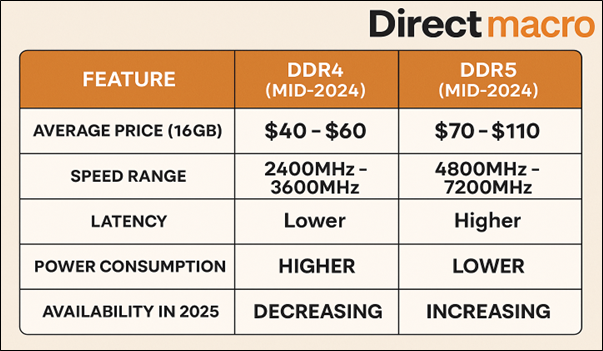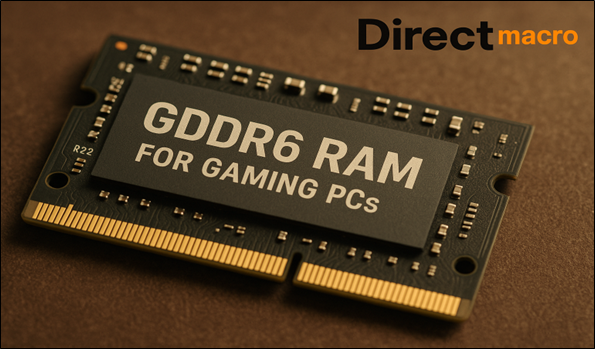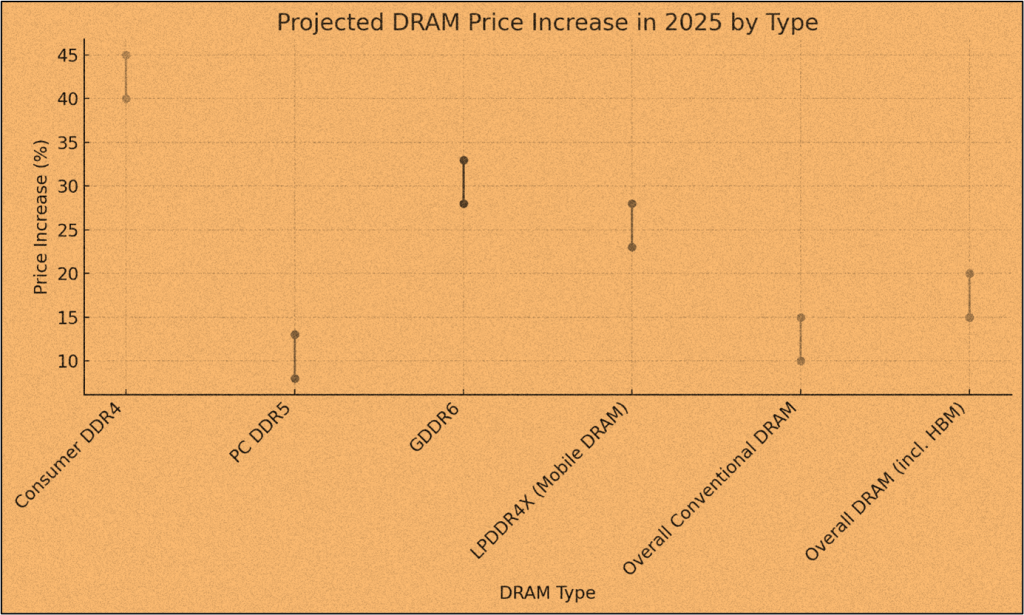Introduction: What’s Happening in 2025?
The memory market is about to undergo significant changes, and the message is clear for consumers, businesses, and PC builders: the DRAM price increase in 2025 is not just a prediction; it is already becoming a reality. Analysts predict significant price increases for all major memory types, with some modules expected to rise by up to 45% in the third quarter of 2025. This comprehensive guide will provide you with the most recent updates and insights required to navigate this volatile market, understand why DRAM prices are rising, and make informed purchasing decisions before prices rise significantly.
Executive Summary: The Impending DRAM Price Surge
The global Dynamic Random Access Memory (DRAM) market is more unstable than ever, and prices are expected to rise sharply throughout 2025, especially in the third quarter. This surge is caused by several factors, including major manufacturers reallocating their strategic capacity, the accelerated DDR4 end-of-life 2025 timeline, increased demand from data centers and AI applications, and a general tightening of supply. Consumers and businesses looking to buy or upgrade RAM should act quickly to secure a good deal before prices rise. If they wait, the costs could increase significantly. The DRAM cost forecast Q3 2025 indicates that an overall price will increase by 10% to 15%, and DDR4 modules for consumers are expected to rise by 40% to 45%. Here is the chart of Q3 DRAM price products:
Why Are DRAM Prices Rising? Unpacking the Market Dynamics
To make informed choices, you need to understand why the DRAM price increased in 2025. This upward trend is being caused by several factors that are all linked to each other:
1. Supply Chain Adjustments and Capacity Shifts
Major DRAM manufacturers, such as Samsung, SK Hynix, and Micron, are strategically shifting their production capacities in a planned manner. Increasingly, the focus is on products with higher profit margins, such as High Bandwidth Memory (HBM) for AI servers and the newer DDR5 standard. This redistribution has a direct impact on the ease of finding older generations, such as DDR4, and, to a lesser extent, GDDR6. HBM isn’t directly competing with DDR4 or DDR5 for consumers, but the shift in manufacturing priorities reduces the overall output of these widely used memory types, leading to a supply squeeze.
2. End-of-Life (EOL) Notices for Legacy DRAM
The formal announcement by major manufacturers that DDR4’s end of life is in 2025 is a significant reason for the current price increase. According to reports, Samsung will stop selling DDR4 in June 2025. Shipments will stop in mid-December. Micron and SK Hynix have the same schedule, with Micron expecting to ship its final DDR4s in the first and second quarters of 2026. This has caused businesses and individuals who still rely heavily on DDR4 for existing systems and new builds to “panic buy” and restock quickly, exacerbating the supply shortage and driving prices up.
3. Geopolitical Factors and Inventory Management
Market behavior is being influenced by ongoing geopolitical tensions, particularly those involving trade between the United States and China, as well as potential tariff hikes. To mitigate future risks, major PC OEMs are actively increasing the number of systems they manufacture and the amount of DRAM they have on hand. This strategic stockpiling contributes to the perception of scarcity and fuels higher pricing.
4. Seasonal Demand and Market Speculation
The third quarter of the year is typically a busy time for electronics sales, as stores restock their shelves for the holidays and new products are launched. This predictable increase in demand, combined with current supply problems and EOL announcements, creates a perfect storm for prices to rise. Additionally, people who make accelerated purchases because they think prices will increase further can fuel the upward spiral even faster.
DDR4 End of Life 2025: A Critical Turning Point, What It Means for Buyers?
The announcement that DDR4 end of life is in 2025 is a significant development for the memory market. At the same time, DDR4 is still widely used in many existing systems and remains a good choice for many new builds due to its affordability. However, its impending discontinuation means that the supply is dwindling, and prices are rising rapidly.
1. Impact on PC Builders and Consumers
It is a crucial decision for individuals who build their own PCs or purchase them. If your current system uses DDR4 or you plan to create a new one with a motherboard and CPU that support DDR4, it is essential to obtain your RAM modules now. The expected 40–45% rise in consumer DDR4 contract prices in Q3 2025 will significantly impact the total cost of a build or upgrade. If you have DDR4, this is probably the best time to upgrade RAM in 2025.
2. The Server Market’s Influence
It is important to note that server applications have priority access to DDR4 output. Cloud service providers (CSPs) are buying a lot of DDR4 servers due to end-of-life policies and high demand for data center expansion. These factors make consumer-grade DDR4 even harder to find, resulting in a significant increase in price when compared to DDR5.
DDR4 vs DDR5 Price Comparison: Which to Choose Now?
The pricing trends for DDR4 and DDR5 are experiencing a clear divergence.

1. Current Market Snapshot
DDR4 is currently more affordable than DDR5, making it a better choice for many budget-conscious individuals. However, this is rapidly changing.
2. Future Price Trajectories
Prices for DDR4 are expected to increase significantly due to a shortage and high demand. On the other hand, DDR5 will have relatively moderate price increases (8–13% for PC DDR5) because it has more concentrated production capacity and is the standard for the future. This means that DDR5 is still generally more expensive per gigabyte than DDR4 was at its lowest, but the gap is closing quickly, and in some cases, DDR4 is already more expensive than DDR5.
3. Strategic Considerations for Upgrades
If your system supports DDR4, it is a good idea to purchase more DDR4 RAM before the price increases. However, DDR4 is quickly becoming less cost-effective for new builds. It might be more prudent to invest in a DDR5-compatible platform now, as the price of DDR5 is more stable over time, and it performs better and lasts longer. This choice has a significant effect on the overall DRAM cost forecast for Q3 2025 for your system.
GDDR6 RAM for Gaming PCs: What Gamers Need to Know?

There are also significant price pressures on GDDR6 RAM for gaming PCs. While system RAM receives much attention, the memory embedded into graphics cards is just as crucial for gaming performance.
1. Demand Drivers and Supply Constraints
The primary reason people want GDDR6 is to restock current and next-generation GPUs, including popular models from NVIDIA and AMD. However, big suppliers are slowly moving capacity to the newer GDDR7 to get ready for the newest GPU releases. This shift creates a short-term supply shortage for GDDR6, particularly for mid-to-entry-level GPUs that continue to rely on it.
2. Anticipated Price Movements
According to industry reports, GDDR6 prices are expected to rise by 28–33% for a substantial gain in the third quarter of 2025. It represents a significant increase that will directly impact the cost of new graphics cards and, consequently, the overall price of a gaming PC.
3. Implications for Next-Gen GPUs
Although GDDR7 is expected to arrive soon for high-end GPUs, gamers will still have to deal with GDDR6 for a broad range of graphics cards. If you are planning to buy a new graphics card in the next few months, you need to take into account the higher costs of GDDR6.
Memory Prices Increase Gaming Impact: Don’t Get Caught Off Guard
The rise in memory prices has a significant impact on gaming that can’t be ignored. RAM is a crucial component of gaming performance, as it impacts loading times, frame rates, and the overall responsiveness of the system.
1. Budgeting for Your Next Gaming Rig
If you are building a new gaming PC, you will need to increase your overall system budget, as the prices of both system RAM (DDR4/DDR5) and graphics RAM (GDDR6) are rising. A build that was once affordable and in the middle range a few months ago could now easily cost into a higher price bracket. This makes it even more crucial to buy RAM before the price jumps.
2. Upgrade Strategies for Existing Systems
If you have an older gaming PC with insufficient RAM, upgrading it at the right time can significantly improve its performance. However, as DDR4 prices skyrocket, this upgrade path is becoming increasingly expensive. For individuals with systems that support DDR5, upgrading to DDR5 modules with increased capacity or higher speeds remains a viable option, even if it incurs a slight cost premium.
Best Time to Upgrade RAM 2025: Act Now and Save Later, Tips for Consumers
The best time to upgrade RAM in 2025 is now or in the immediate future, based on the current market analysis and DRAM cost forecast for Q3 2025. In the short to medium term, waiting for prices to level off is not a good idea or viable strategy because they are continuing to rise.
1. Identifying the Purchase Window
The time to buy DDR4 at lower prices is quickly running out. For DDR5 and GDDR6, prices are currently high, but they are likely to remain elevated for some time. To decrease the effects of the most significant price increases, it is best to buy proactively in Q2 and early Q3 of 2025.
2. Proactive Procurement for Businesses
Businesses, especially those that perform system integration, server deployment, or purchase a large number of PC procurement, should consider buying memory modules in bulk to lock in current prices. Delays in purchasing items can significantly increase project budgets and operational costs.
DRAM Cost Forecast Q3 2025: Breaking Down the Numbers
The most recent DRAM cost forecast Q3 2025 from top market research companies like Trend Force gives a clear, though challenging, picture:
These figures show how important it is to buy DRAM before the price jumps, especially for DDR4 and GDDR6.
Actionable Recommendations: Secure Your Memory Today
There are clear and strong indications of a massive DRAM price increase in 2025. Here are some actionable recommendations you have to consider before making a purchase:
For Individual Consumers
- Upgrade DDR4 Now: If your laptop or PC uses DDR4 and you’ve been thinking about getting a RAM upgrade, do it right away. This is your last opportunity to avoid the most significant price increases for this type of memory.
- Consider DDR5 for New Builds: When building a new PC, think about how much DDR5 will be worth in the long run. DDR5 may be a better long-term choice because its prices are likely to remain stable, and it offers better performance, even though the initial cost of the platform (motherboard and CPU) may be higher.
- Graphics Card Purchases: If you need a new graphics card, especially one that uses GDDR6, consider buying it sooner rather than later.
For System Integrators and OEMs
- Strategic Stockpiling: Make sure to get DDR4, DDR5, and GDDR6 modules as soon as possible to meet expected demand. Use forward contracts to lock in current prices whenever possible.
- Adjust Pricing Models: To stay profitable, you should include the anticipated rise in memory prices in your product pricing plans for Q3 of 2025 and beyond.
- Communicate with Customers: Inform your clients that prices may increase due to rising memory costs, allowing them to plan accordingly.
For Businesses and Data Centers
- Accelerate Server Upgrades: If you have planned server upgrades that utilize DDR4, speed up these projects to take advantage of current prices and make sure you always have enough stock of DDR4 before it becomes too expensive or hard to find.
- Evaluate DDR5 Adoption: For new server deployments, speed up the switch to DDR5-based platforms to take advantage of its performance benefits and more stable long-term pricing trajectory compared to legacy DDR4.
- Monitor HBM Developments: It is not the primary focus of this discussion, but businesses that rely on AI infrastructure should also keep an eye on HBM pricing because its demand directly affects the overall allocation of DRAM capacity.
Conclusion
The memory market is expected to undergo significant changes. A massive DRAM price increase is expected, especially in the third quarter. Analysts predict that consumer DDR4 demand will increase by 40% to 45% due to announcements regarding the end of DDR4 production in 2025, as well as manufacturers’ focus on server DDR4 and the newer DDR5. GDDR6 RAM for gaming PCs is also expected to increase significantly (28–33%), which will directly affect the cost of GPUs and the overall memory prices, expanding the gaming impact.
The DRAM cost forecast Q3 2025 shows a general broad upward trend. This is the ideal time to upgrade RAM in 2025 or purchase new RAM modules. We hope this guide provides all the necessary information about why DRAM prices are rising. There is a shortage because OEMs are strategically building up their inventories and reallocating capacity to high-bandwidth memory (HBM) and DDR5. Consumers and businesses need to purchase RAM before prices increase across all memory types to avoid significant price jumps.
For more assistance, contact us at (855) 483-7810 or visit our website for bulk orders.
Frequently Asked Questions (FAQs)
Q1: Why is there such a significant difference in the projected price increase between DDR4 and DDR5?
The reason behind the significant price rise is the announcement of the DDR4 end of life in 2025. This is because major manufacturers are intentionally cutting back on their supply to focus on making DDR5 and HBM, to phase out DDR4 by 2025. This makes things scarce, which raises prices as stock runs out. Prices for DDR5 are also increasing, but that is because the market is becoming tighter and there is a significant demand for both the current and future standard. Manufacturers are working hard to make more of it.
Q2: Is it still worth buying DDR4 RAM for a new PC build in mid-2025?
DDR4 is becoming less useful for budget builds. Its expected price increase of 40–45% means it could soon cost as much as, or more than, DDR5, which has a significantly worse performance-to-cost ratio. If your motherboard and CPU support DDR4, then you may want to consider upgrading your RAM now. However, if you are building a new PC, you should strongly consider getting a DDR5 platform. It will be more future-proof and may be worth more in the long run.
Q3: How will the GDDR6 price increase affect the gaming PC market?
A 28–33% price increase for GDDR6 RAM for gaming PCs will directly affect the prices of mid- to high-end graphics cards that use this memory. This will likely increase the overall cost of new gaming PCs and make it more expensive for gamers to upgrade their GPUs. It is an essential factor for your memory, as gaming impacts planning.
Q4: When exactly is the “best time to upgrade RAM 2025” to avoid the most significant price increases?
The best time to upgrade is NOW, in the second and third quarters of 2025. Prices are expected to increase the most in Q3 2025, particularly for consumer DDR4. If you act before or early in Q3, you can buy memory at lower prices than you will later in the quarter.
Q5: Are there any alternatives to traditional DRAM to mitigate these price increases?
Sadly, there are no affordable and widely compatible direct alternatives for consumers at present. DDR4 and DDR5 are still the most common types of memory. NVMe SSDs are fast storage devices, but they are not the same as RAM. GDDR7 is the next generation of graphics memory, but at first, it will only be available for high-end, expensive GPUs. Buying technologies that are already available before their prices go up is the best way to deal with rising costs.
